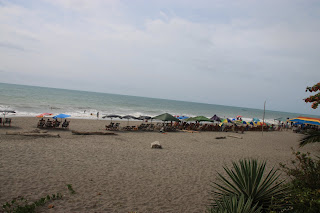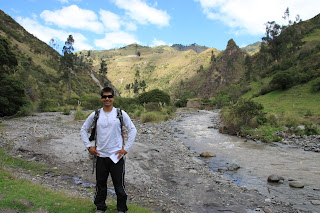Hey Everyone!
Sorry it has been a while since we have taken the time to update you....so here we go!
Following our amazing trip to the Galapagos we were ready to leave Quito for good and see more of Ecuador. The first stop we made was in Otavalo (about 2 hours northeast of Quito) to see the Saturday indigenous market. Otavalo's Saturday market is Ecuador's largest and you can find almost anything you can imagine (from wide array of colourful handicrafts and knock-off designer clothing, to fresh fruit and veggies and food stalls).
Shaina walking the aisles of the market in Otavalo
We couldn't spend the day at the market and come home empty handed, so Marsh picked up an Ecuador soccer jersey and Shaina found some nice turquoise earrings and necklace!
After Otavalo, we headed south to Latacunga (1.5 hours south of Quito) which was the town we would use as a base for a few mountainous adventures. The first adventure was a 4 day/3 night trek on the Quilotoa Loop that was dubbed the 'best hike in Ecuador!' The trek ended at Lake Quilotoa (the huge crater of an inactive volcano that is now filled with salt water!). The trek started after a bus ride to the small town of Sigchos. After 4 hours of walking, some beautiful scenery in the Andes, and a couple of mean blisters on Shaina's left heel we arrived in Insilivi where we spent the night.
Shaina on the walk from Sigchos to Insilivi
The second day of the hike was a 5 hour walk from Isinlivi to Chugchilan. The scenery on day two was amazing as we walked along a river in a deep valley until climbing way up and out of the valley to Chugchilan.
Marsh on the walk from Isinlivi to Chugchilan
The view of the Canyon from just outside of Chugchilan
The 3rd day was the most physically demanding day of the trek and had us climbing for 6 hours from Chugchilan to Quilotoa (elevation 3900 meters above sea level). However, when we reached the top of the mountain, the view we found was amazing!
Lake Quilotoa
On day 4 we walked down to the lake to take for a closer look. We had read in our Lonely Planet that we would be able to ride horses back up to the top of the crater, but to our dismay there were no horses at the lake.....it turns out you had to arrange for the horses before descending to the lake....so we had to hike it back up before catching the afternoon bus back to Latacunga.
One of the reasons we had decided to hike the Quilotoa loop was to help acclimatize ourselves to hiking at altitude, as our next mission was to climb Cotopaxi (Ecuador's second highest peak at 5847 meters above sea level!). It is a two day task. On day one you drive into Cotopaxi National Park and up to the parking lot at 4500 masl, and then climb to the refuge (4800 masl) where you eat dinner and sleep until midnight. On day two you begin your climb in the middle of the night in hopes of reaching the peak (5847 masl) by sunrise at 6am before descending back down to the refuge and driving back to Latacunga (2800 masl).
Cotopaxi Volcano from the roof of our hostel in Latacunga
We were very excited about the possibility of conquering such a high peak! However, our confidence began to waiver when we started getting some bad "signs"..... First, Shaina got sick from gluten the day before we were supposed to head to the mountain so we postponed our trip by 1 day. Then, when we did go, our guide's SUV got a flat tire on the way to the national park.....and because it was Sunday it was hard to find a place that was open in order to fix the flat. However, after an hour or two we got it fixed and made our way to the entrance of the national park....only to find out that the park was temporarily closed because there were too many visitors that day and the road up to the volcano was too dangerous with all the traffic. After a 20-30 minute wait they reopened the gate so were still able to get into the park. By this time it was late afternoon, about the time we'd normally be in the refuge relaxing.
Marsh inside the park still excited to climb!
Although it looks like a lovely day in the picture, when we got out of the car at the parking lot the wind was howling and the temperature was just above zero. We still managed to climb up to the refuge just before dark (2 hours later than we were supposed to arrive), but on the way up Shaina's camel pack (water container) leaked due to the significant increase in altitude and soaked one of our sleeping bags! So after our dinner at the refuge, we crammed into one sleeping bag and tried to get some rest before the climb at midnight. However, things continued going south as Shaina became a victim of altitude sickness and was too busy puking to attempt the climb :(. Marsh still felt okay so when midnight rolled around he got out of bed, grabbed his crampons, ice axe, and poles and started the climb with our guide. It was freezing cold and the wind was howling but progress was being made. Marsh and Julian (the guide) had reached 5200 masl by 3am and were the highest of all the people attempting the summit. However, at this point the wind picked up another notch and the guides decided it was unsafe to continue (so you wouldn't get blown into an ice crevice) and everyone had to return to the refuge. Julian said that it was the windiest night he had ever seen in his 16 years of climbing Cotopaxi and one of the few times nobody made the summit. So that was the icing on the cake for our string of bad luck!
After returning to the refuge and waiting until sunrise, we returned to Latacunga for some sleep. Shaina was back to normal after descending back to 'normal' at 2800 masl in Latacunga.
So Cotopaxi did not go as planned but it was still a learning experience and we think we'll stick to the trekking and leave the mountaineering to the professionals....
Today (Tuesday) we headed to Banos for some R&R. It is a quaint town in the valley of the Tungurahua volcano which provides 4 natural not springs or thermal baths (hence the name on the town). It's a lovely spot, with nice hostels and restaurants. We're now on the eastern edge of the Andes, approaching the jungle, where we'll head next.
We spent the afternoon soaking in the natural thermal baths, alternating between hot and cold for 'la vida y la salud'. Tomorrow we're going to bike to some waterfalls and then come back for a steam bath and the spa! A welcome change from Latacunga and Cotopaxi!
The 'Virgin of the Holy Water' Thermal Baths in Banos
Next, we'll make a brief stop in the jungle in the town of Tena (we're waiting to do a jungle tour in Peru or Bolivia) and then it's back up north to the coast (to the town of Atacames - via Quito) for some beach time!
Hope everyone is doing well at home! send us updates!
Love, Marsh and Shaina
xoxo
P.S. we got our wedding photos back in digital format, so let us know if you want to see 1000 pictures of us! (and guests) :)




















